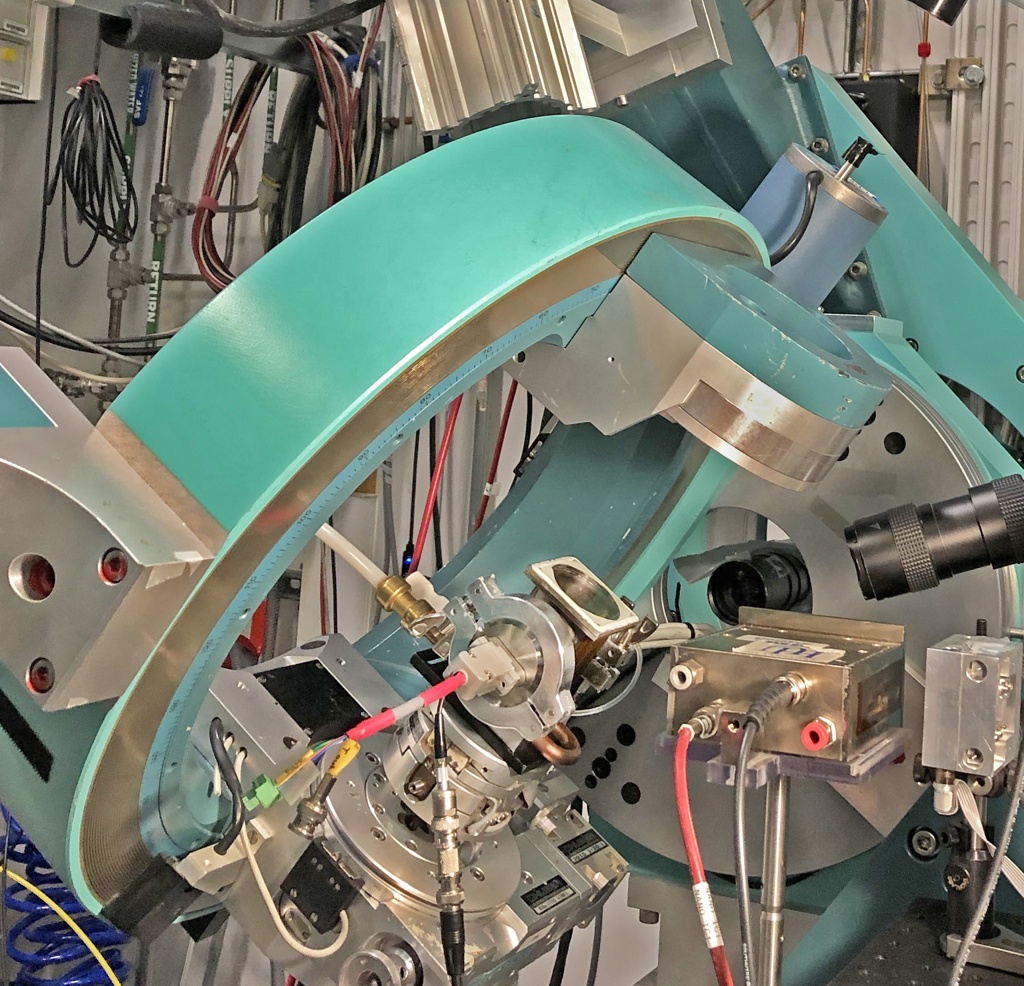Tiny Chip-Based Device Performs Ultrafast Modulation of X-Rays
About Optica
20 April 2021
Tiny Chip-Based Device Performs Ultrafast Modulation of X-Rays
New optics-on-a-chip device paves way to capturing fast chemical, material and biological processes
WASHINGTON — Researchers have developed new x-ray optics that can be used to harness extremely fast pulses in a package that is significantly smaller and lighter than conventional devices used to modulate x-rays. The new optics are based on microscopic chip-based devices known as microelectromechanical systems (MEMS).

Caption: The new x-ray MEMS device is used inside this experiment enclosure at the Advanced Photon Source. Shown is the 6-circle diffractometer that manipulates the MEMS optics in a vacuum chamber.
Credit: Jin Wang
“Our new ultrafast optics-on-a-chip is poised to enable x-ray research and applications that could have a broad impact on understanding fast-evolving chemical, material and biological processes,” said research team leader Jin Wang from the U.S Department of Energy’s Argonne National Laboratory. “This could aid in the development of more efficient solar cells and batteries, advanced computer storage materials and devices, and more effective drugs for fighting diseases.”
In The Optical Society (OSA) journal Optics Express, the researchers demonstrated their new x-ray optics-on-a-chip device, which measures about 250 micrometers and weighs just 3 micrograms, using the x-ray source at Argonne’s Advanced Photon Source synchrotron. The tiny device performed 100 to 1,000 times faster than conventional x-ray optics, which tend to be bulky.
“Although we demonstrated the device in a large x-ray synchrotron facility, when fully developed, it could be used with conventional x-ray generators found in scientific labs or hospitals,” said Wang. “The same technology could also be used to develop other devices such as precise dosage delivery systems for radiation therapy or fast x-ray scanners for non-destructive diagnostics.”
Capturing fast processes
X-rays can be used to capture very fast processes such as chemical reactions or the quickly changing dynamics of biological molecules. However, this requires an extremely high-speed camera with a fast shutter speed. Because many materials that are opaque to light are transparent to x-rays it can be difficult to improve the speed of shutters effective for x-rays.
To solve this challenge, the research team, consisting of scientists from Argonne’s Advanced Photon Source and Center for Nanoscale Materials, turned to MEMS-based devices. “In addition to being used in many of the electronics we use daily, MEMS are also used to manipulate light for high-speed communication,” said Wang. “We wanted to find out if MEMS-based photonic devices can perform similar functions for x-rays as they do with visible or infrared light.”

Caption: The researchers tested their new x-ray optics-on-a-chip device using x-ray source at Argonne's Advanced Photon Source synchrotron, which is pictured from above.
Credit: Argonne National Laboratory
In the new work, the researchers show that the extremely small size and weight of their MEMS-based shutter allows it to oscillate at speeds equavilent to about one million revolutions per minute (rpm). The researchers leveraged this high speed and the MEMS material’s x-ray diffractive property to create an extremely fast x-ray shutter.
Boosting shutter speed
Using their new optics-on-a-chip with x-rays produced by the Advanced Photon Source, the researchers demonstrated that it could provide a stable shutter speed as fast as one nanosecond with an extremely high on/off contrast. This could be used to extract single x-ray pulses from the source, even if the pulses were only 2.8 nanoseconds apart from each other.
“We show that our new chip-based technology can perform functions not possible with conventional large optics,” said Wang. “This can be used to create ultrafast probes for studying fast processes in novel materials.”
The researchers are now working to make the devices more versatile and robust so that they can be used continuously over long periods of time. They are also integrating the peripheral systems used with the tiny chip-based MEMS devices into a deployable stand-alone instrument.
The work was supported by DOE’s Office of Science. The Advanced Photon Source and Center for Nanoscale Materials are DOE Office of Science user facilities.
Paper: P. Chen, I. W. Jung, D. A. Walko, Z. Li, Y. Gao, T. Mooney, G. K. Shenoy, D. Lopez, J. Wang, “Optics-on-a-chip for ultrafast manipulation of 350-MHz hard x-ray pulses,” Opt. Express, 29, 9, 13624-13640 (2021).
DOI: https://doi.org/10.1364/OE.411023.
Caption: Three-dimensional animation of rotating MEMS and x-ray pulse picking.
Credit: Miqoqi Chu
About Optica Publishing Group
Optica Publishing Group is a division of the society, Optica, Advancing Optics and Photonics Worldwide. It publishes the largest collection of peer-reviewed and most-cited content in optics and photonics, including 18 prestigious journals, the society’s flagship member magazine, and papers and videos from more than 835 conferences. With over 400,000 journal articles, conference papers and videos to search, discover and access, our publications portfolio represents the full range of research in the field from around the globe.
About Optics Express
Optics Express reports on scientific and technology innovations in all aspects of optics and photonics. The bi-weekly journal provides rapid publication of original, peer-reviewed papers. It is published by Optica Publishing Group and led by Editor-in-Chief James Leger of the University of Minnesota, USA. Optics Express is an open-access journal and is available at no cost to readers online. For more information, visit Optics Express.
About The Optical Society
The Optical Society (OSA) is dedicated to promoting the generation, application, archiving, and dissemination of knowledge in optics and photonics worldwide. Founded in 1916, it is the leading organization for scientists, engineers, business professionals, students, and others interested in the science of light. OSA’s renowned publications, meetings, online resources, and in-person activities fuel discoveries, shape real-life applications and accelerate scientific, technical, and educational achievement.
About Optics Express
Optics Express reports on scientific and technology innovations in all aspects of optics and photonics. The bi-weekly journal provides rapid publication of original, peer-reviewed papers. It is published by Optica Publishing Group and led by Editor-in-Chief James Leger of the University of Minnesota, USA. Optics Express is an open-access journal and is available at no cost to readers online. For more information, visit Optics Express.
Media Contact
